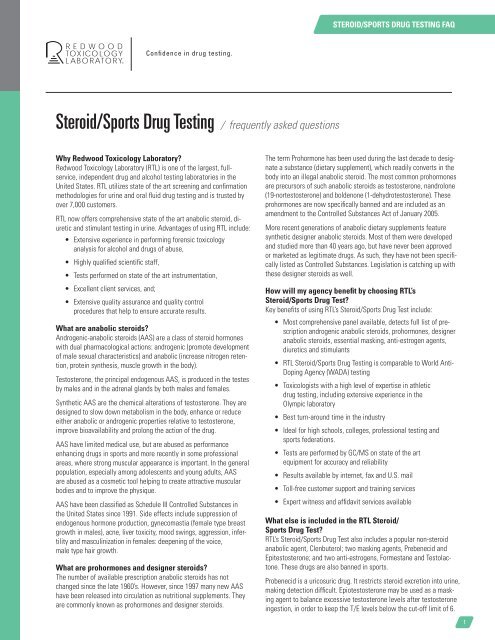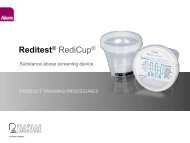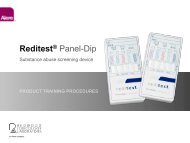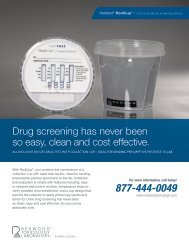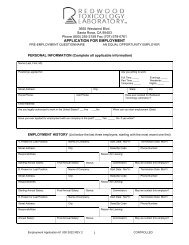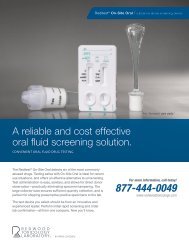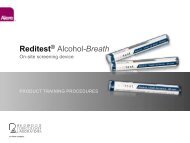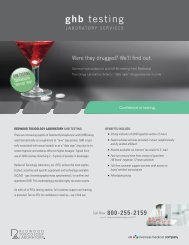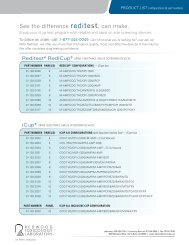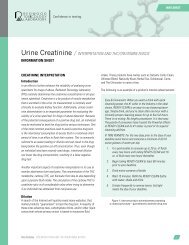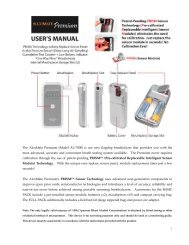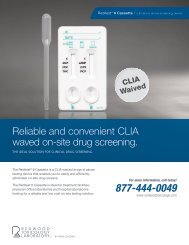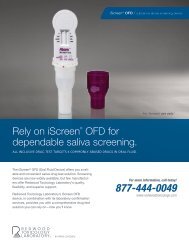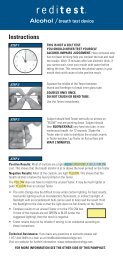Steroid/Sports Drug Testing FAQ - Redwood Toxicology Laboratory
Steroid/Sports Drug Testing FAQ - Redwood Toxicology Laboratory
Steroid/Sports Drug Testing FAQ - Redwood Toxicology Laboratory
Create successful ePaper yourself
Turn your PDF publications into a flip-book with our unique Google optimized e-Paper software.
<strong>Steroid</strong>/<strong>Sports</strong> <strong>Drug</strong> TestING <strong>FAQ</strong><br />
<strong>Steroid</strong>/<strong>Sports</strong> <strong>Drug</strong> <strong>Testing</strong> / frequently asked questions<br />
Why <strong>Redwood</strong> <strong>Toxicology</strong> <strong>Laboratory</strong><br />
<strong>Redwood</strong> <strong>Toxicology</strong> <strong>Laboratory</strong> (RTL) is one of the largest, fullservice,<br />
independent drug and alcohol testing laboratories in the<br />
United States. RTL utilizes state of the art screening and confirmation<br />
methodologies for urine and oral fluid drug testing and is trusted by<br />
over 7,000 customers.<br />
RTL now offers comprehensive state of the art anabolic steroid, diuretic<br />
and stimulant testing in urine. Advantages of using RTL include:<br />
• Extensive experience in performing forensic toxicology<br />
analysis for alcohol and drugs of abuse,<br />
• Highly qualified scientific staff,<br />
• Tests performed on state of the art instrumentation,<br />
• Excellent client services, and;<br />
• Extensive quality assurance and quality control<br />
procedures that help to ensure accurate results.<br />
What are anabolic steroids<br />
Androgenic-anabolic steroids (AAS) are a class of steroid hormones<br />
with dual pharmacological actions: androgenic (promote development<br />
of male sexual characteristics) and anabolic (increase nitrogen retention,<br />
protein synthesis, muscle growth in the body).<br />
Testosterone, the principal endogenous AAS, is produced in the testes<br />
by males and in the adrenal glands by both males and females.<br />
Synthetic AAS are the chemical alterations of testosterone. They are<br />
designed to slow down metabolism in the body, enhance or reduce<br />
either anabolic or androgenic properties relative to testosterone,<br />
improve bioavailability and prolong the action of the drug.<br />
AAS have limited medical use, but are abused as performance<br />
enhancing drugs in sports and more recently in some professional<br />
areas, where strong muscular appearance is important. In the general<br />
population, especially among adolescents and young adults, AAS<br />
are abused as a cosmetic tool helping to create attractive muscular<br />
bodies and to improve the physique.<br />
AAS have been classified as Schedule III Controlled Substances in<br />
the United States since 1991. Side effects include suppression of<br />
endogenous hormone production, gynecomastia (female type breast<br />
growth in males), acne, liver toxicity, mood swings, aggression, infertility<br />
and masculinization in females: deepening of the voice,<br />
male type hair growth.<br />
What are prohormones and designer steroids<br />
The number of available prescription anabolic steroids has not<br />
changed since the late 1960’s. However, since 1997 many new AAS<br />
have been released into circulation as nutritional supplements. They<br />
are commonly known as prohormones and designer steroids.<br />
The term Prohormone has been used during the last decade to designate<br />
a substance (dietary supplement), which readily converts in the<br />
body into an illegal anabolic steroid. The most common prohormones<br />
are precursors of such anabolic steroids as testosterone, nandrolone<br />
(19-nortestosterone) and boldenone (1-dehydrotestosterone). These<br />
prohormones are now specifically banned and are included as an<br />
amendment to the Controlled Substances Act of January 2005.<br />
More recent generations of anabolic dietary supplements feature<br />
synthetic designer anabolic steroids. Most of them were developed<br />
and studied more than 40 years ago, but have never been approved<br />
or marketed as legitimate drugs. As such, they have not been specifically<br />
listed as Controlled Substances. Legislation is catching up with<br />
these designer steroids as well.<br />
How will my agency benefit by choosing RTL’s<br />
<strong>Steroid</strong>/<strong>Sports</strong> <strong>Drug</strong> Test<br />
Key benefits of using RTL’s <strong>Steroid</strong>/<strong>Sports</strong> <strong>Drug</strong> Test include:<br />
• Most comprehensive panel available, detects full list of prescription<br />
androgenic anabolic steroids, prohormones, designer<br />
anabolic steroids, essential masking, anti-estrogen agents,<br />
diuretics and stimulants<br />
• RTL <strong>Steroid</strong>/<strong>Sports</strong> <strong>Drug</strong> <strong>Testing</strong> is comparable to World Anti-<br />
Doping Agency (WADA) testing<br />
• Toxicologists with a high level of expertise in athletic<br />
drug testing, including extensive experience in the<br />
Olympic laboratory<br />
• Best turn-around time in the industry<br />
• Ideal for high schools, colleges, professional testing and<br />
sports federations.<br />
• Tests are performed by GC/MS on state of the art<br />
equipment for accuracy and reliability<br />
• Results available by internet, fax and U.S. mail<br />
• Toll-free customer support and training services<br />
• Expert witness and affidavit services available<br />
What else is included in the RTL <strong>Steroid</strong>/<br />
<strong>Sports</strong> <strong>Drug</strong> Test<br />
RTL’s <strong>Steroid</strong>/<strong>Sports</strong> <strong>Drug</strong> Test also includes a popular non-steroid<br />
anabolic agent, Clenbuterol; two masking agents, Prebenecid and<br />
Epitestosterone; and two anti-estrogens, Formestane and Testolactone.<br />
These drugs are also banned in sports.<br />
Probenecid is a uricosuric drug. It restricts steroid excretion into urine,<br />
making detection difficult. Epiotestosterone may be used as a masking<br />
agent to balance excessive testosterone levels after testosterone<br />
ingestion, in order to keep the T/E levels below the cut-off limit of 6.<br />
1
Anti-estrogens are often used to counteract so-called aromatization,<br />
conversion of excessive amounts of abused testosterone into female<br />
hormones, estrogens. Estrogens cause unpleasant effect in males such<br />
as female type breast growth.<br />
What steroids on the test panel are popular<br />
Statistically, nandrolone, testosterone and stanozolol are found in<br />
routine testing more often than the others. However, consumer preferences<br />
vary depending on supply. Boldenone became very popular,<br />
when its precursor was released into the supplement market and<br />
was heavily advertised in the media. It was followed by the efficient<br />
anabolic steroid, 1-testosterone and its precursors. Then methyl-1-<br />
testosterone appeared as an even stronger drug. Each new generation<br />
of designer steroids seems to be more efficient pharmacologically than<br />
the previous ones. The most recent designer steroids, desoxymethyltestosterone,<br />
methasterone, prostanozol and 6-methylandrostendione,<br />
are now often seen in routine testing.<br />
Why are some steroids on the RTL steroid<br />
panel grouped together<br />
Some steroids, when ingested, convert into each other forming an<br />
identical set of urinary metabolites. It is impossible to determine<br />
which drug in the group was administered.<br />
Why are steroids screened by GC/MS<br />
Most steroids break down in the body into multiple metabolites that<br />
are excreted in urine at low concentrations. These substances are<br />
similar to each other and to the endogenous steroids, normally present<br />
in urine in higher concentrations. RTL performs GC/MS screening for<br />
the <strong>Steroid</strong> Test because it provides an efficient separation and specific<br />
detection of individual compounds.<br />
The GC/MS confirmation procedure is specific to each individual steroid.<br />
For multiple positive screens, multiple individual confirmations are<br />
set up. Specimens that screen positive are also confirmed by<br />
GC/MS using a separate aliquot of urine.<br />
How accurate and reliable is the RTL <strong>Steroid</strong>/<strong>Sports</strong><br />
<strong>Drug</strong> Test<br />
RTL utilizes the most sophisticated, sensitive, and specific equipment<br />
and technology available. This methodology provides highly accurate<br />
results. The RTL <strong>Steroid</strong> Test shows what steroids or metabolites are<br />
present in the urine at the time the sample was collected. In most<br />
cases, confirmation is based on positive identification of more than<br />
one metabolite (metabolic pattern), providing added confidence. Accurate<br />
quantification is performed for nandrolone and testosterone with<br />
cut-off levels of 2 ng/mL (nandrolone metabolite) and testosterone to<br />
epitestosteroine ratio above 6 (T/E > 6).<br />
What is the T/E ratio<br />
Testosterone and its precursors may be endogenous (produced in the<br />
body naturally) or exogenous (ingested as drugs or supplements). The<br />
T/E ratio is used to distinguish between the two. This ratio is a urine<br />
concentration ratio of two steroids, testosterone (T) and its natural<br />
isomer, epitestosterone (E). The normal average ratio is approximately<br />
1, with individual variation on both sides, either higher or lower.<br />
Ingestion of exogenous testosterone or its precursors suppresses internal<br />
steroid production in the body. Both endogenous T and E would<br />
be suppressed. However, total testosterone concentration in urine will<br />
rise above normal due to ingested drug. Low E and high T cause the<br />
T/E ratio to rise above 6 (cut-off), indicating testosterone abuse.<br />
How long can steroids be detected in urine<br />
Detection time may vary from a few days (short-term pill) to as long<br />
as 12-18 months (oil-based injection), depending on the pharmacological<br />
form used, route of administration, length of usage and quantity.<br />
Individual differences may also contribute to the duration of the<br />
drug in the body. Test results cannot show when the drug was used,<br />
i.e. how long before the urine was collected.<br />
What are diuretics<br />
Diuretics elevate the rate of bodily urine excretion (diuresis). All diuretics<br />
increase the excretion of water from the body, although each class<br />
of diuretics does so in a distinct way employing different mechanisms<br />
of action. Use of diuretics is prohibited in sports. Increased urine flow<br />
would reduce concentrations of banned performance enhancing substances<br />
in urine such as anabolic steroids, thus complicating their detection<br />
in doping control (masking). In sports where weight categories<br />
are involved diuretics are abused as weight reducing agents. Diuretic<br />
abuse in sports is unethical and dangerous for athlete health (dehydration).<br />
Diuretic testing is a part of routine doping control in sports.<br />
What are stimulants<br />
Stimulants are psychoactive drugs that induce temporary improvements<br />
in mental and/or physical function. The effects of stimulants<br />
include enhanced alertness, wakefulness, endurance, productivity and<br />
motivation; increased arousal, locomotion, heart rate/blood pressure;<br />
and a perception of a diminished requirement for food and sleep.<br />
Stimulants include the following: amphetamine, methamphetamine,<br />
cocaine and ecstasy (MDMA), which are classified as drugs of abuse<br />
in the US; ephedrine and its derivatives, which can be found in many<br />
cold medications; and many other prescription drugs and illicit substances<br />
used worldwide. Stimulant abuse can lead to addiction and is<br />
eventually destructive to human health.<br />
How stable are steroid metabolites in urine<br />
Refrigerated or frozen urine shows very little or no steroid metabolite<br />
degradation during prolonged (several years) storage.<br />
How much does RTL’s <strong>Steroid</strong>/<strong>Sports</strong> <strong>Drug</strong> Test cost<br />
For information about steroid/sport drug test pricing, contact the<br />
RTL sales staff toll-free at (800) 255-2159.<br />
How will RTL report results<br />
RTL offers steroid reporting by internet (www.webtoxicology.com), U.S.<br />
mail or facsimile. Please indicate your preferred method at the time<br />
of account set-up.<br />
How to sign up for <strong>Steroid</strong>/<strong>Sports</strong> <strong>Drug</strong> <strong>Testing</strong><br />
Contact RTL to set up your account. Let us know that you are interested<br />
in <strong>Steroid</strong>/<strong>Sports</strong> <strong>Drug</strong> <strong>Testing</strong> and indicate any other drugs of<br />
abuse you would like to test. Compliance with RTL non-pretesting<br />
policy is required. Call us toll-free at (800) 255-2159.<br />
<strong>Laboratory</strong>: 800-255-2159 // Screening Devices: 877-444-0049 // Fax: 707-577-8102<br />
3650 Westwind Blvd., Santa Rosa, CA 95403 // www.redwoodtoxicology.com<br />
<strong>Steroid</strong>/<strong>Sports</strong> <strong>Drug</strong> <strong>Testing</strong> FREQUENTLY ASKED QUESTIONS 2<br />
11 000 3260 REV6


